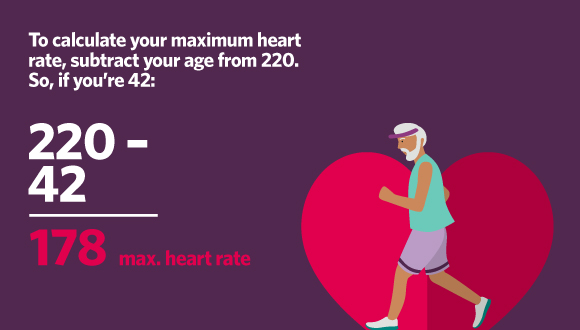Do you have a healthy resting heart rate?
Published June 2024 | 5 min read
Expert contributors Professor Diane Fatkin, cardiologist at the Victor Chang Cardiac Research Institute; Associate Professor Belinda Parmenter, accredited exercise physiologist at the University of New South Wales
Words by Trudie McConnochie
What is a normal heart rate and what can you learn about your health from checking your pulse? We ask the experts.
It races when you’re about to give a presentation at work, slows down when you’re falling asleep in front of the TV at night, and (according to rom-coms) might just miss a beat when you see the person you love. Your heart rate can fluctuate wildly during your day-to-day life, but sometimes changes to your heart rate over time can indicate a problem.
“Your heart rate can provide important clues to your heart’s function and general health,” says Professor Diane Fatkin, a cardiologist at the Victor Chang Cardiac Research Institute.
Whether you’re monitoring your heart rate on a health tracker or you want to know if you’re getting the most out of your exercise sessions, here’s what you need to know about your heart rate.

What is a normal heart rate?
Your resting heart rate is a measurement of how many times your heart beats when you’re relaxed, with a normal resting heart rate (or pulse) sitting somewhere between 60 and 100 beats per minute (bpm). As a general rule, having a low resting heart rate could indicate that you’re fit, while a faster resting heart rate might be a sign your heart is working too hard to circulate blood.
“If the resting heart rate is too fast [more than 100 bpm] or too slow [less than 60 bpm], then there may be underlying issues that need medical attention,” says Prof Fatkin.
Your heart rate, she explains, can be affected by:
- age – heart rate tends to slow as we age
- gender – women tend to have higher heart rates
- medications – e.g. beta blockers, which slow heart rate
- caffeine, alcohol and smoking
- genetics
- emotions – e.g. stress and excitement
- hydration – your heart tends to beat faster when you’re dehydrated
- pregnancy – pregnant women will often see an increase in heart rate
- fitness level – athletes’ resting heart rates tend to be lower
- temperature – if it’s hot and humid, your heart will pump faster
- time of day – usually, your heart rate slows at night.
How to calculate your resting heart rate
If you want to measure your heart rate, you could use a wearable health tracker, such as a Fitbit or Apple Watch, which works by either detecting the electrical current generated by your heart with every beat or using infrared light to see the expansion of your arteries as blood is pumped through them.
You can also measure your heart rate manually. After sitting or lying down for at least 5 minutes, find a pulse on the inside of your wrist, down from your thumb. You can also find a pulse on the inside of your elbow, side of your neck and top of the foot.
Using a timer, count how many times your heart pulses in 30 seconds, then double that to find your resting heart rate per minute.
Avoid checking your heart rate within an hour of drinking caffeine or within two hours of exercise or a stressful event, as these are likely to raise your heart rate.
What should your heart rate be during exercise?
Associate Professor Belinda Parmenter, an accredited exercise physiologist at the University of New South Wales, says tracking your heart rate while exercising can help you achieve your health and fitness goals.
“If you’re trying to improve your cardiorespiratory fitness, lose weight or help control your blood pressure, for example, there are specific intensities and durations you should be aiming for,” she explains.
“A general rule is if you’re trying to improve your cardiorespiratory fitness, then you should be aiming for moderate to vigorous intensity exercise, and we define that as around 75 to 85% of your textbook maximum heart rate. This is the maximum heart rate your heart technically should be able to get to and is calculated based on your age.”
To calculate your estimated maximum heart rate, subtract your age from 220. For example, if you’re 42, your estimated maximum heart rate would be 178. Vigorous intensity for you would be an estimated heart rate of between 133 and 151 bpm.

If you’re exercising for weight loss, you need to exercise for longer, says Assoc Prof Parmenter. Aiming for moderate intensity – “60 to 75% of that maximum” – will help you exercise longer without tiring, while still getting great heart-health benefits.
What type of exercise is best for heart rate?
Assoc Prof Parmenter says it doesn’t really matter what type of exercise you choose, as long as it’s something you enjoy so that you commit to it regularly – that will be best for your heart in the long run.
If you want maximum bang for your exercise buck, HIIT (high intensity interval training) – where a few minutes of vigorous exercise is followed by lower-intensity activity or rest, then repeated – is often lauded for its heart health benefits. But Assoc Prof Parmenter says HIIT isn’t suited for people with heart conditions, and those who don’t like vigorous exercise. She adds that it’s essential to consult with your GP before trying this exercise, or any lifestyle change, especially if you have a pre-existing medical condition. Moderate intensity exercise – which means you’re able to talk but not sing while doing an activity like brisk walking – is just as worthy. By tracking your heart rate, you’ll be able to check whether you’re exercising at a moderate or vigorous intensity.
“We can actually improve someone’s overall fitness and blood pressure and blood glucose levels – all of those cardiovascular risk factors – just by doing moderate intensity exercise,” she says. “You don’t have to do it for long, either – moderate intensity recommendations are just 22 minutes a day. If you’re doing vigorous exercise, you get to drop it to 11 minutes a day. So vigorous intensity just means you do less – that’s the difference.”
Managing your heart rate
If you’re wondering when to worry about a low heart rate, Prof Fatkin says that short-term fluctuations are common during the day.
“Although it is beneficial to know about your heart rate under different conditions, it is important not to get overly anxious about this,” she stresses.
However, if you’re experiencing an unusually high or low heart rate along with dizziness, blackouts or heart palpitations, she recommends seeing a doctor.
“Palpitations can include a feeling that the heart is racing, intermittent skipped or extra strong beats, or periods in which the heartbeat is irregularly irregular,” she says. “Other symptoms that may be indicative of heart problems include shortness of breath, chest pain or tightness and unexplained tiredness.”
If you’re looking for ways to improve your heart health, Prof Fatkin recommends adopting a healthy lifestyle to keep your ticker in good order.
“This includes regular exercise, maintaining a healthy weight, a balanced diet, avoiding smoking and excessive alcohol, and having regular check-ups to look for high blood pressure, diabetes and high cholesterol,” she says. “These conditions can promote heart trouble and need to be picked up early and treated.”
Get a free heart and diabetes health check
To help keep our members’ hearts healthy, we’re offering a free heart and diabetes health check for eligible HCF members at selected HCF branches*. It only takes 10 minutes, and you can get your results right away.
Related articles
Workout tips for a healthy heart
Research shows it’s the consistency of your workout routine that helps keeps your heart healthy, not how many kilometres you run. Here’s how to make the most of your exercise.
Five tips for healthy ageing
Your lifestyle can impact how fit and well you feel as you grow older. Luckily there are some easy, science-backed ways to help you feel happier, fitter and stronger for longer.
How to prevent heart disease
One in four Australians will die from heart disease. But, research shows by taking better care of our hearts with some easy-to-adopt, healthy habits, we can prevent heart disease.
Menopause and Hearth Health
Women's bodies go through lots of change before and during menopause. While the focus is often on symptoms, there are good reasons to prioritise your heart health, too.
IMPORTANT INFORMATION
* Eligibility criteria applies. For more information see hcf.com.au/victorchang
This communication contains information which is copyright to The Hospitals Contribution Fund of Australia Limited (HCF). It should not be copied, disclosed or distributed without the authority of HCF. Except as required by law, HCF does not represent, warrant and/or guarantee that this communication is free from errors, virus, interception or interference. All reasonable efforts have been taken to ensure the accuracy of material contained on this website. It’s not intended that this website be comprehensive or render advice. HCF members should rely on authoritative advice they seek from qualified practitioners in the health and medical fields as the information provided on this website is general information only and may not be suitable to individual circumstances or health needs. Please check with your health professional before making any dietary, medical or other health decisions as a result of reading this website.